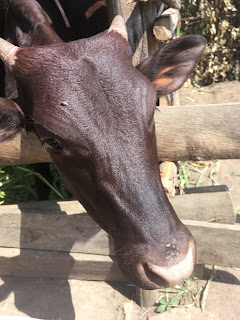Hello Family and Friends.
Greetings from Kigali,
This morning we had the opportunity to have a conversation with two ex-tigists. After the 1994 genocide against the Tutsi’s, many prisons were very full due the large number of perpetrators of this genocide. With over 1 million killed, over 120,000 were placed in prison after the Rwanda Patriot Force (RPF) took back the government in July of 1994. With crowded prisons being an issue, the Rwandan government set up a system called Tig. Individuals that were convicted and served time in prison also received time doing community service before they were to be released back into the public. Tig is a form of community service where individuals do a variety of things in order to serve the community.
Both individuals told their stories. First, the man explained how he was 24 when the genocide started in April of 1994. He explained how he was living with his mother and father when a group of militia men came and persuaded him to follow them while they escort a Tutsi man to be killed. So, with being fearful, he decided to follow because he felt like he had no choice. After returning from this event, he remembers his father being very upset with him because he knew what his son had done. To this day, he still does not know how his father knows, but somehow he could sense that his son had done something very bad. Although he was released from jail with the presidential pardon that was given to individuals that confessed, he still had to go through the Gacaca courts systems, Rwanda set up in order to properly prosecute any perpetrator of the genocide against the Tutsi’s. He was sentenced to 7 years in jail, but only served 2 with 3 months and 5 days in Tig before being released back into society. While serving this time, he began being an advocator for other individuals to confess to their crimes and ask for forgiveness because it took him a while to be able to do that himself. He was even trained to go around to other prisons in order to help convince others to accept what they had done and also ask for forgiveness. He realized that he cannot deny the killings but he realizes he had to show the community that he has changed. He talked to many individuals because if they were to confess to the crimes, they would receive a lesser sentence. For many, this worked and others still refuse to confess. After being releases, he helped Tutsi individuals build homes and helped them to also rebuild their lives. His advice to us was to not follow the ideas of the bad politicians.
The second women began by apologizing to us because she knew that we knew she had done very bad things. She explained how during the genocide, the militia came to her door and wanted her to follow them away from her home. She obeyed and individuals with this militia killed Tutsi individuals along the way. After the RPF took over the government, she too was put in prison. She was sentenced to 7 years and 3 years of community service. She emphasized the importance of telling the Gacaca courts about how individuals were killed and where their bodies were placed. She did just that and confessed to her wrongdoings. After she was released back into society, she helped plant avocado trees and also gave individuals goats in order to show her sorrow. She told us that she participated because she had no choice but to do so. Her choice was to participate or die. Her advice to us was when leaders tell you to do bad, do not listen.
 Overall, both of their stories were very powerful. Throughout this week we have talked to both victims and rescuers, but this meeting was also very important in understanding the 1994 genocide against the Tutsi’s.
Overall, both of their stories were very powerful. Throughout this week we have talked to both victims and rescuers, but this meeting was also very important in understanding the 1994 genocide against the Tutsi’s.
After this conversation, we had another conversation about our homestay families. We will be leaving tonight to stay with our homestay families for a week. While many are nervous, others are very excited. I cannot wait for this experience! Be sure to keep following this blog to hear fun stories about our different experiences.
Go Cavs!
Karly Keller







